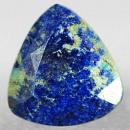|
|
||||||||||||||||
|
||||||||||||||||
|
||||||
|
|
|
|
Azurite
|
|
| | |
| Discovered in 1824; IMA status: Valid (pre-IMA; Grandfathered) | ||
|
| ||
|
Chemistry |
|
|
| |
|
Cu3(CO3)2(OH)2 | |
|
|
Copper Carbonate Hydroxide |
|
Molecular Weight: |
344.67 gm |
|
Composition: |
Copper |
55.31 % |
Cu |
69.24 % |
CuO |
|
|
Hydrogen |
0.58 % |
H |
5.23 % |
H2O |
|
|
Carbon |
6.97 % |
C |
25.54 % |
CO2 |
|
|
Oxygen |
37.14 % |
O |
|
|
|
|
|
100.00 % |
|
100.00 % |
= TOTAL OXIDE |
|
|
|
||||
|
Classification |
|
|
| |
|
Carbonates | |
|
5/C.01-10 | |
|
|
5 : CARBONATES (NITRATES)
|
|
Related to: |
n/a |
|
Varieties: |
Kupferblau, Zincazurite |
|
Synonyms: |
Armenite (of Delamétherie), Azure Copper Ore, Azurite (of Beudant), Blue Carbonate of Copper, Blue Malachite, Chessy copper, Chessylite, Lasur, Lasurite (of Haidinger) |
|
|
|
|
Crystal Data |
|
|
|
|
|
Crystals are typically complex, with over 100 forms recorded, to 30 cm. Tabular on {001}, less commonly so on {102} or {102}; short to long prismatic along [001], with prominent {110} and {100}, or along [010], with wedgelike terminations. As rhomboidal, lenticular, or spherical subparallel aggregates, which may form rosettes; also as internally radial stalactitic or columnar aggregates; botryoidal, drusy, earthy, massive. |
|
|
Rare; twin planes {101}, {102}, {001} |
|
|
|
|
|
Physical Properties |
|
|
|
|
|
Perfect (but interrupted) on {011}, Fair on {100}, Poor on {110} |
|
|
Conchoidal |
|
|
Brittle |
|
|
3.5 - 4.0 |
|
|
3.77 - 3.89 (g/cm3) |
|
|
None |
|
|
Not Radioactive |
|
|
Other: |
Soluble in dilute acids, ammonia, and hot concentrated solutions of NaHCO3. Slowly decomposed with removal of CO2 by boiling, but not by cold water. |
|
|
|
|
Optical Properties |
|
|
|
|
|
Azure-Blue, Berlin Blue, very dark to pale Blue; pale Blue in transmitted light. |
|
|
Transparent to Subtranslucent to Opaque |
|
|
Vitreous to Subadamantine |
|
|
1.730 - 1.838 Biaxial ( + ) |
|
|
0.1080 |
|
|
Strong; r > v |
|
|
Visible; pleochroic in blue, with absorption Z greater than Y greater than X. |
|
|
|
|
|
Occurances |
|
|
|
|
|
Geological Setting: |
Found largely in the oxidized portions of copper deposits, it is a secondary mineral formed by the action of carbonated water acting on copper-containing minerals, or from Cu-containing solutions, such as CuSO^4 or CuCl^2 reacting with limestones. |
|
Common Associations: |
Malachite, Chrysocolla, Brochantite, Antlerite, Cuprite, Cerussite, Smithsonite, Calcite, Dolomite. |
|
Common Impurities: |
None |
|
Type Locality: |
Chessy-les-Mines, Rhône, Rhône-Alpes, France |
|
Year Discovered: |
1824 |
|
View mineral photos: | |
|
|
|
|
More Information |
|
|
|
|
|
| |
|
|
|
|
Azurite is
found in many localities worldwide such as Chessy, France;
Morenci and Bisbee, Arizona, USA; Kelly, New Mexico,
USA; Queensland, Australia; Italy; Greece, Russia, Tsumeb,
Namibia; and Zacatecas, Mexico. |
|
|
We have not photographed our Azurite gems yet. Please check back soon!
|
